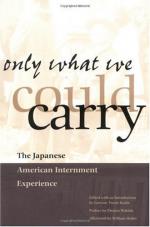|
This section contains 254 words (approx. 1 page at 300 words per page) |

|
Once the Japanese evacuees were transferred from the assembly centers to permanent camps, many quickly set about trying to restore a semblance of normality to their lives. The task was made more difficult by the less-than-livable conditions many found at the relocation camps, most of which were located in the remote desert areas of Utah, Idaho, Colorado, Arizona, and California. Barracksstyle housing had barely been completed and the rooms were furnished with nothing more than a few cots topped with strawstuffed mattresses. Despite great hardship and a chronic lack of material, the internees quickly attempted to make their surroundings more habitable. They foraged for lumber to build furniture for their apartments, and partitions for increased privacy in the noisy and open barracks. The many professional gardeners and farmers among the internees transformed the barren wasteland around them into productive farms and lush green...
|
This section contains 254 words (approx. 1 page at 300 words per page) |

|




